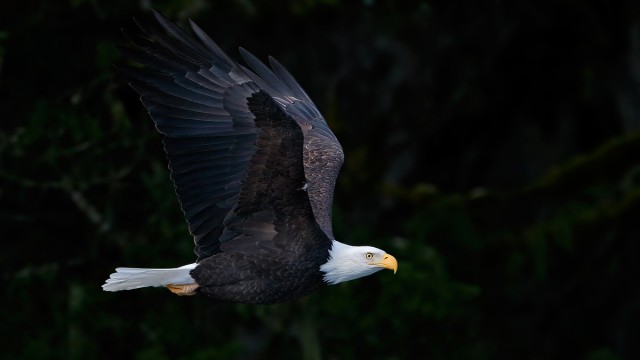
One year with EF 400 DO IS II
It has nearly been a year since I published my review of the EF 400mm DO IS II, since then I have had many opportunities to use this lens in the field under different conditions, and with different camera bodies. The images below were all produced with the EF 400mm f/4 DO IS II with and without extenders with Canon EOS 1D-X, EOS 5DS R, EOS 5D Mark III and the EOS 7D Mark II.
Please click on each image to see it larger and sharper.
Shooting from a confined space:
I used the EF 400 DO II when shooting raptors in southern California with my friend Dave Salem. To avoid disturbing the skittish raptors, we shoot from Dave’s truck. It is quite difficult to work with my EF 600mm f/4 IS II in the confined space of the vehicle, especially when changing extenders. Sometimes it isn’t possible to swing the lens in order to track birds in flight given the large diameter of the lens thorough the relatively small rear seat window. With the EF 400mm f/4 DO IS II, however, it is much easier to maneuver the lens and also to add or remove extenders. Given the light weight of the rig, there is no need for a bean bag which will also frees up a bit more space.

Red-tailed Hawk. ESO-1D X EF 400mm f/4 DO IS II plus Extender 2X III. ISO 1250. f/8 at 1/3200sec. Hand held from vehicle. No bean bag. Click on the image to expand.
This location in particular is very hard on the AF because of constant strong heat shimmers and dust (from vehicles driving on gravel road). The combination of the EF 400mm f/4 DO IS II and EF Extender 2X III performed very well on my 1D X. Below is another example where the hawk took off towards the camera, the AF has to drive really fast to keep up with the incoming bird for this kind of shot.

Red-tailes hawk. EOS-1D X, EF 400mm f/4 DO IS II plus EF extender 2X III. ISO 1250. f/8 at 1/3200sec. Hand held from vehicle. Click on the image to expand.
To take the photo below I had to point my lens downward as the hawk was initially perched on the ground. This would have been a difficult shot had I been using a bean bag. Again the AF had no trouble locking on the hawk.
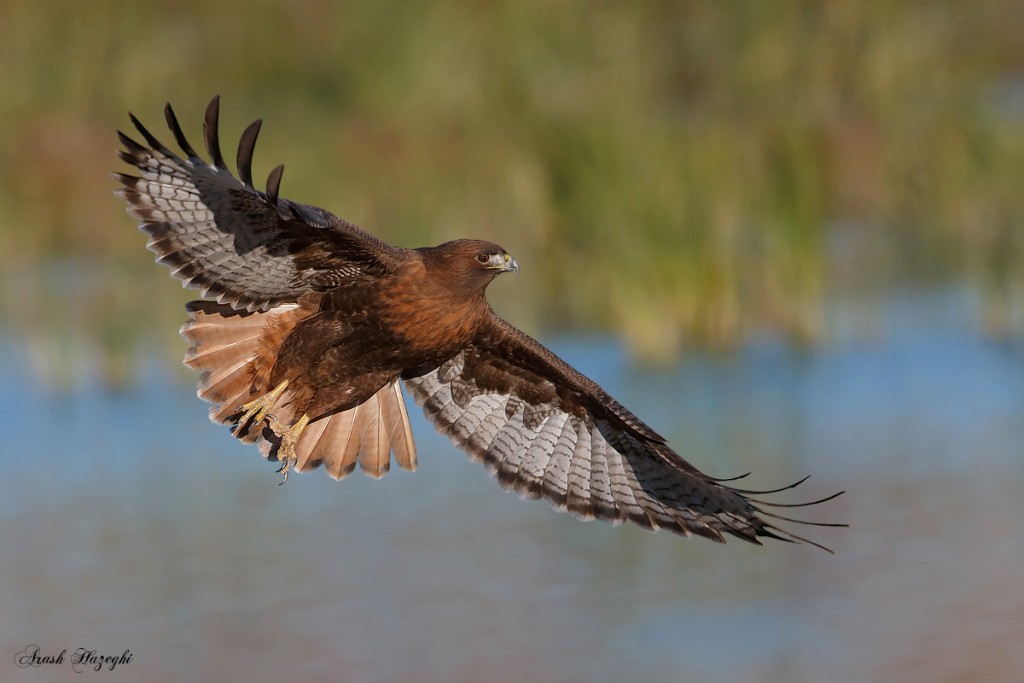
Rufous morph Red-tailed Hawk. EF 400mm f/4 DO IS II plus EF Extender 2X III. ISO 800. f.8 at 1/2500sec. Hand Held from truck. Click on the image to expand.

Female American Kestrel. EOS-1D X EF 400mm f/4 DO IS II plus EF Extender 2X III. ISO 1600. f/8 at 1/2500sec. Hand held from truck. Click on the image to expand.
While I haven’t had the opportunity to shoot with the 400mm f/4 DO II from a boat but I expect it to be equally effective in that situation as well.
Traveling with restrictions
Another situation where the EF 400mm f/4 DO IS II can save the day is when traveling in small aircraft. Many carriers now use smaller jets for US/Canada cross-border flights. The overhead bins in these aircraft cannot fit the larger super-telephoto lenses such as the EF 500mm f/4 IS II or the EF 600mm f/4 IS II. Some regional Alaska flights use propeller aircraft with even smaller bins. Previously I used to take my EF 300mm f/2.8 IS II for such trips but there were many occasions where I felt I could use more reach. The EF 400mm f/4 DO IS II now solves that problem. It can fit in a small back pack that fits in any overhead bin and even under the aircraft seat if needed.

Small backpack containing an EOS-1D X, EF 400 mm f/4 DO IS II, EF extenders 1.4X and 2X III. Canon 16-35 F/4 IS L. Cables, card reader and other accessories. Fits easily in the overhead bin of the CRJ700.
I spend a few days photographing in Vancouver area, in a variety of situations. The skies were cloudy and the light was always low, you might expect that at 800mm f/8, the combination of the EF 400mm f/4 DO IS II and Extender 2X III may not be very useful. But, this combination proved very capable with the 1D X even capturing flight frames with varied backgrounds in very low light. What I learned while using this combination was that given the lens’s light weight you can get sharp flight shots at 800mm hand held down to 1/800sec (with proper technique). With my EF 600mm f/4 SI II plus extenders, to get the sharpest RAW files, I prefer to stay above 1/2500sec. In other words the lighter weight makes up for the smaller aperture when hand holding this lens.
From the shooting info. you can guess how low the light was at the time of shooting. At f/8, the AF is limited to center point only (plus four expansion points) so precise tracking becomes more critical, but at the same time the light weight of the rig makes it easier to track in-flight shots.

British Columbia Bald Eagle. EOS-1D X, EF 400mm f/4 DO IS II plus Extender 2X III. ISO 3200. f/8 at a/1000sec. Hand held. Click on the image to expand.
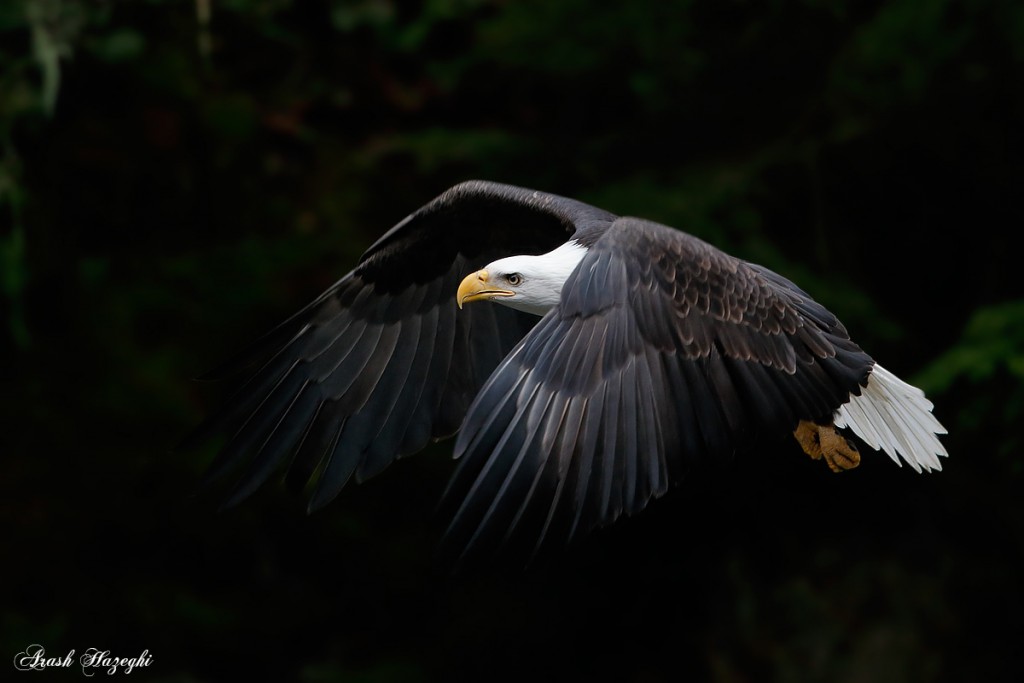
British Columbia Bald Eagle. EOS-1D X, EF 400mm f/4 DO IS II. ISO 3200. f/8 at 1/800sec. Hand held. Click on the image to expand.
For perched shots the same combo produced tack sharp RAW files down to 1/200sec. The image below was shot at 1/320sec hand held. The bald eagles were photographed near a river, the terrain was very uneven with ice-covered rocks and soft snow. It would have been more difficult to navigate had I been using a heavier rig.

British Columbia Bald Eagle. EOS-1D X, EF 400mm f/4 DO IS II. ISO 2500. f/8 at 1/320sec. Hand held. Click on the image to expand.
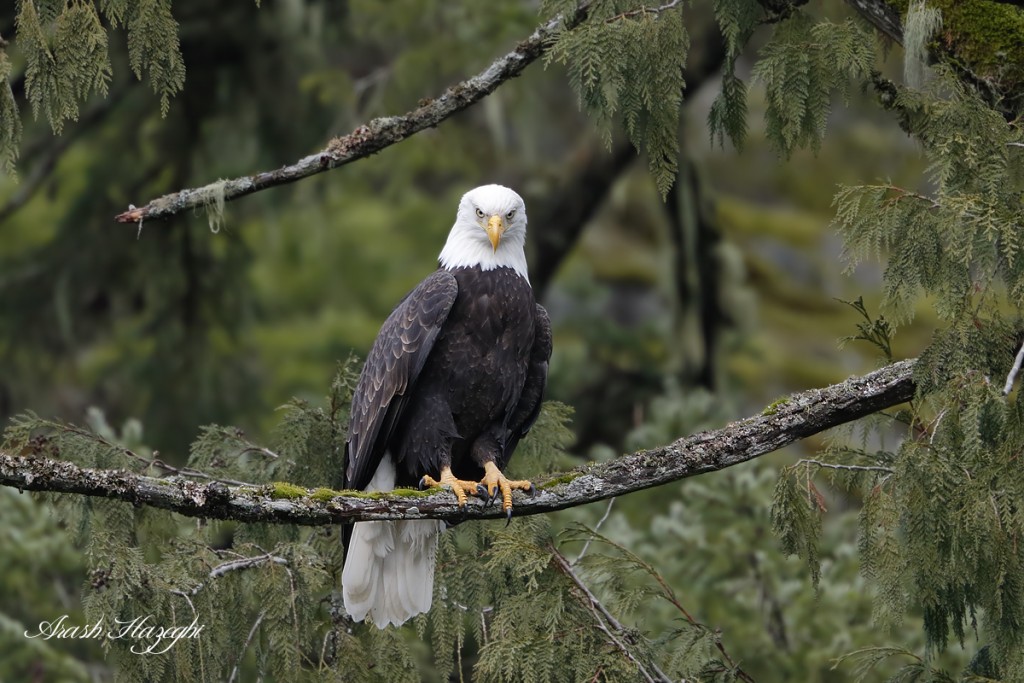
British Columbia Bald Eagle. EOS-1D X, EF 400mm f/4 DO IS II plus Extender 2X III. ISO 2500. f/8 at 1/500sec. Hand held. Click on the image to expand.
I spent a morning in Victoria, BC to shoot woodpeckers and song birds from a blind. It was a relatively dark morning so I had to lower the shutter speed. I quickly realized that I could consistently get sharp shots down to 1/200sec hand held with IS set to mode 1. The frames that weren’t quite sharp were almost all due to the bird movement. The EF 400mm f/4 DO IS II proved a powerful tool for shooting from a blind. Not being confined to a tripod is especially helpful when there is simultaneous activity on multiple perches, as you can rapidly point to different perches.

Male Pileated Woodpecker. EOS-1D X, EF 400mm f/4 DO IS II plus Extender 1.4X III. ISO 1600. f/5.6 1/200sec. Hand held from blind. Click on the image above to expand.
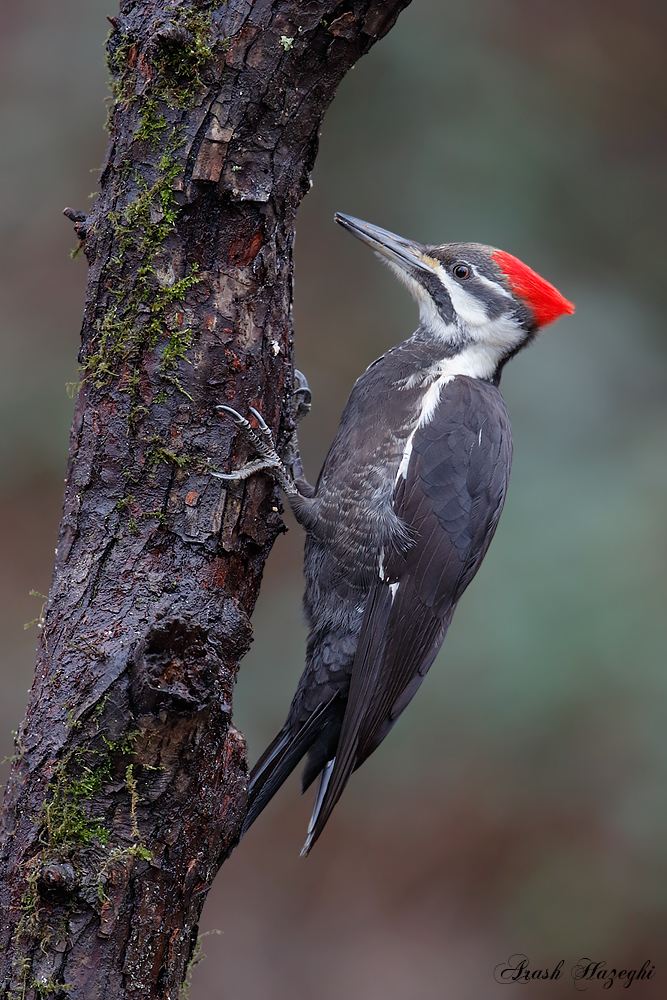
Female Pileated Woodpecker. EOS-1D X, EF 400mm f/4 DO IS II plus Extender EF 1.4X III. ISO 1600. f.5,6 at 1/200sec. Hand hedl from blind. Click on the image to expand.
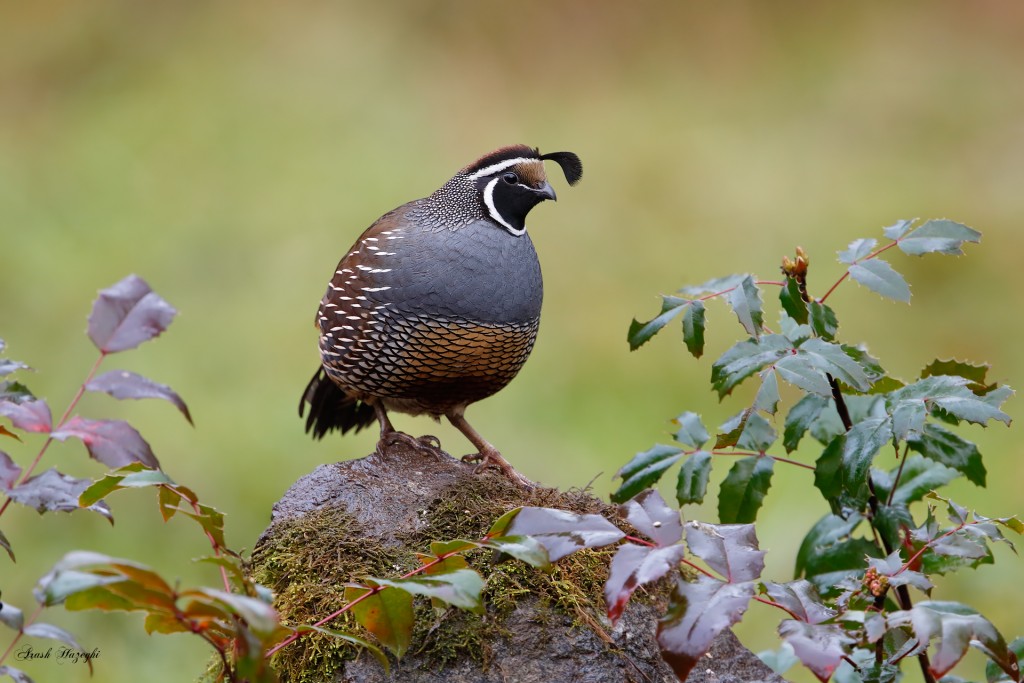
Male California Quail. EOS-1D X, EF 400mm f/4 DO IS II plus Extender 1.4X III. ISO 1600. f/5.6 at 1/200sec. Hand held from blind. Click on the image to expand.
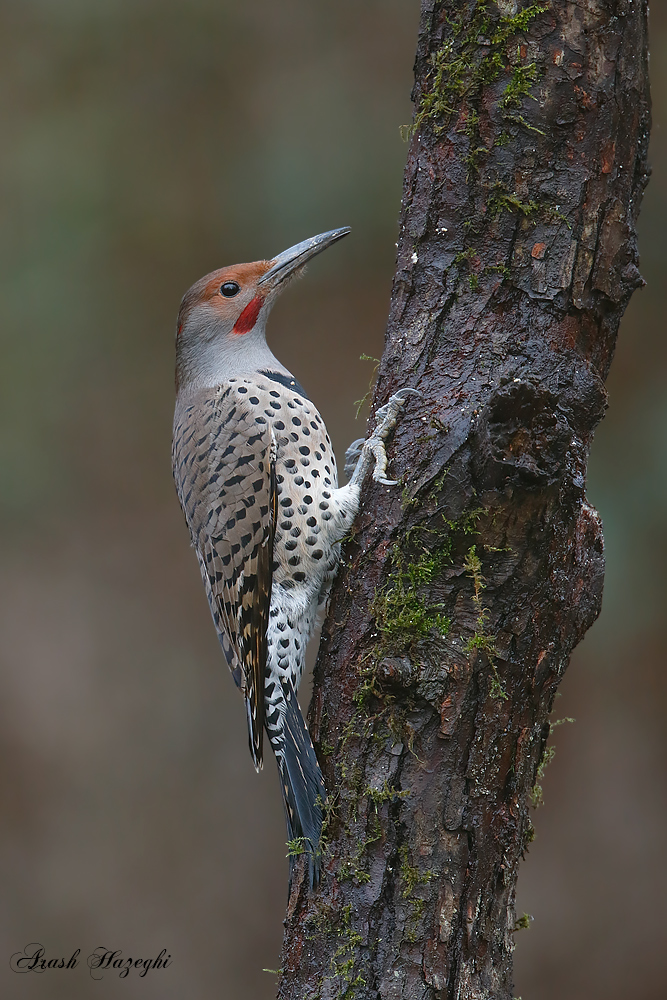
Northern Flicker. EOS-1D X, EF 400mm f/4 DO IS II plus Extender 1.4X III. ISO 1600. f/5.6 at 1/200sec. Hand held from blind. Click on the image to expand.
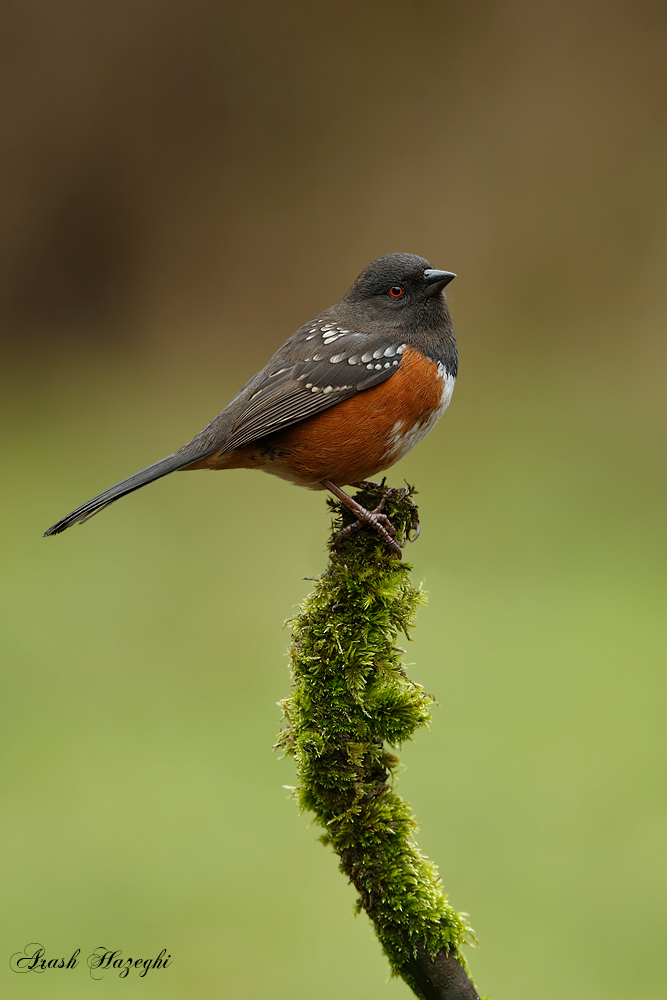
Spotted Towhee, EOS-1D X, EF 400mm f/4 DO IS II plus Extender 1.4X III. ISO 1600. f/5.6 at 1/250sec. Hand held from blind. Click on the image to expand. see 100% crop below.
Below is the 100% crop from RAW, processed by DPP4.

100% unsharpened crop from RAW for the image above. Click on the image to see full size. Proceed with Canon DPP 4.4.
Using EF 400mm f/4 DO IS II with other camera bodies
I also used the EF 400mm f/4 DO IS II with other (current) EOS bodies, including the EOS 7D Mark II, EOS 5D Mark III and the EOS 5DS R. As expected, unlike the EOS-1D X, with addition of an extender the servo drive speed reduces with these bodies. With the EF Extender 1.4X III, this decrease is not significant enough to affect AF field performance, in fact it’s hardly noticeable. With the EF Extender 2X III however, the AF does take a significant hit. It is still usable for tracking larger and slower birds such as a pelican flying parallel to the back of the camera but it’s not fast enough to keep up with a kingfisher or an oyster catcher in flight.
On several occasions I attempted to photograph a belted kingfisher in flight with the EOS 7D Mark II and the EF400mm f/4 DO IS II plus EF Extender 2X III, but I had to quickly switch back to Extender 1.4X III to gain the required AF speed.
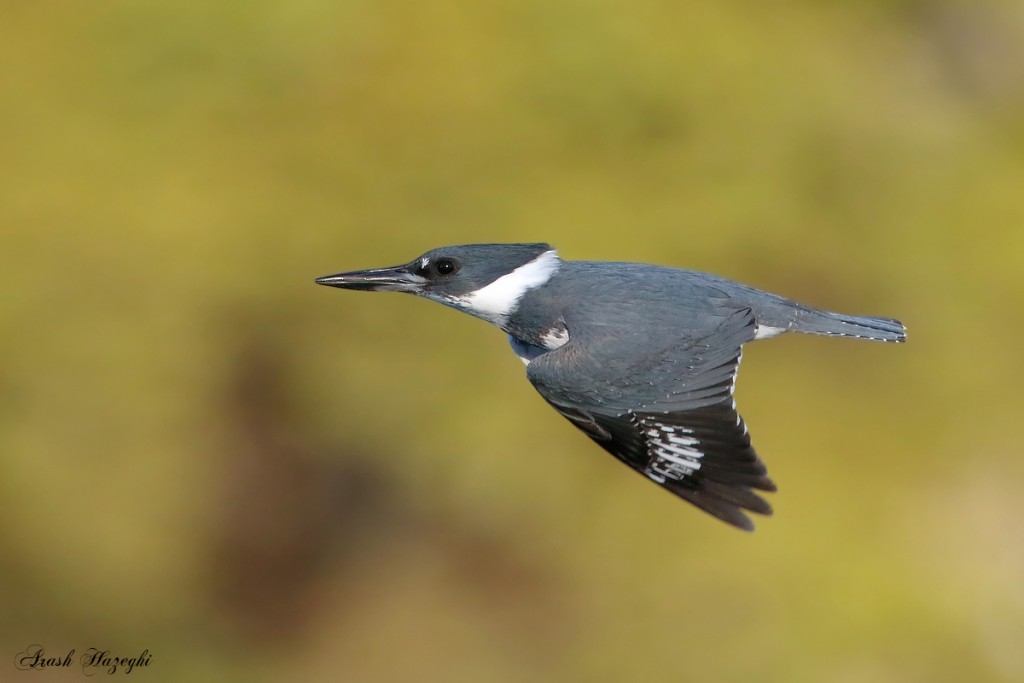
Belted Kingfisher in flight. EOS 7D Mark II, EF 400mm f/4 DO IS II plus EF Extender 1.4X III. ISO 1000. f/5.6 at 1/2500 sec. Hand held. Click on the image to expand.
With the Extender 2X III mounted the 7D Mark II felt “more at home” shooting the Kingfisher when he was perched.

Belted Kingfisher. EOS 7D Mark II. EF 400mm f/4 DO IS II plus EF Extender 2X III. ISO 1250. f/8 at 1/1250sec. Hand held. Click on the image to expand.

Belted Kingfisher in flight. EOS 7D Mark II, EF 400mm f/4 DO IS II plus Extender 2X III. ISO 1000. F/5.6 at 1/2500sec. Hand held. Click on the image to expand.
The EOS 5D Mark III also performed similarly to the EOS 7D Mark II. That is, the the AF with Extender 2X III is adequate for perched, floating or slow flying birds but not quite fast enough for general in-flight photography, especially shooting raptors in flight.
I also had several opportunities photographing with the 55-Mega pixel EOS 5DS R. The first concern with the high-resolution sensor was image sharpness with the combination of the EF 400mm f/4 DO IS II and EF Extender 2X III combination. This combination proved to out-resolve the sensor at lower ISO’s (<=400) delivering tack sharp RAW files with a level of fine detail I had not seen before.

Great Egret, EOS 5DS R, EF 400mm f/4 DO IS II plus EF Extender 2X III. ISO 1600. F/8 at 1/1000sec. Hand held. Click on the image to expand.
The image below (American Coot) shows the level of detail typically captured with the EOS 5DsR at a medium ISO. At higher ISO’s however, the images quickly become grainy impacting sharpness and micro-contrast at pixel level. Nevertheless, this is a limitation of the camera’s sensor rather than the lens’s optics.

American Coot. EOS 5DSR, EF 400mm f/4 DO IS II plus extender 2X III. ISO 1250. F/8 at 1/1600sec. Hand held. Click on the image to expand.
Below is a 100% crop from RAW using DPP4 conversion as explained in the DPP4 Guide.

100% unsharpened Crop from RAW. EOS 5DsR with EF400mm f/4 DO IS II plus Extender 2X III. ISO 1250. f/8 at 1/1600sec. Hand held. Processed with DPP 4.4. Click on the image to see full size.
In terms of AF performance the EOS 5DS R proved somewhat slower than both EOS 5D Mark III and the EOS 7D Mark II. With the Extender 2X III I didn’t have much luck in capturing flight frames so I wouldn’t recommend it for flight shots. In addition to the slow servo drive the EOS 5Ds R seems to have much longer shutter lag than the other bodies. Most likely Canon had to slow down the mirror damping mechanism to reduce the motion blur at pixel level given the small pixels of the camera. Of course, with patience and good technique (e.g. pre-focus) you can capture ideal in-flight frames with the EOS 5DS R. It could be very frustrating however so I don’t recommend it for in-flight or action photography. Needless to say, the target audience of this camera primarily consists of landscape and studio shooters for whom AF/speed isn’t a factor.
Conclusion and Observations
Overall after using the EF 400mm f/4 DO IS II for about a year it remains an impressive and extremely capable piece of glass. Especially, when used with the EOS-1D X where there is little compromise when the lens is used with the EF Extender 2X III at 800mm f/8. With the newly announced EOS-1D X Mark II, I expect the AF to improve further by enabling all 61 AF sensors at f/8 (with current EOS-1D X only the center point and 4 expansion points are available at f/8). This lens really shines for travel and and shooting from confined spaces or in very low light conditions where using a tripod is not possible. It compliments my EF 600mm f/4 IS II very nicely, I’d go this far to say these two lenses serve all of my bird photography needs at the moment.
All images were processed with DPP4 and prepared for final presentation using the methods explained in detail in the DPP4 guide as well as the new Post Processing Guide coauthored by myself and Arthur Morris.
Thanks for the update. I bought my 400DOII after reading your first review. My initial tests were just OK. I did not like the doughnut shaped specular highlights and the lack of contrast–or so it initially seemed. It was wicked sharp though even with the 1.4x TC. (I did notice a very slight drop off in sharpness with the 2x) I took it to Alaska with me for the reasons you mention–my 500 was just too big and bulky for the small planes and boat. After a week of shooting, I am now a complete fan. Never noticed any weird highlights or lack of contrast in real life work. Love the size and weight. Now if Canon would only make a 600DO!
Hi Bill,
The new lens doesn’t have a lack of contrast or donugnut highlights. That was the old lens. The contrast and booked are indistinguishable from other EF MK II super telephoto lenses if you shoot with them side by side
Best
Fine shots Arash. Love the backgrounds. The detail looks superb.
Truly extraordinary photos, Ari.
I am tempted to sell my EF 600mm f/4 IS II and buy this lens.
Hi Dave,
This lens is a complement but not a substitute for the 600mm f/4 IS II.
I have a question concerning your guides. I have ordered a pair of 1DXIIs which I hope to get in the next 2 weeks. I was going to order your noise reduction guide but now wonder if I should wait for an updated version including the vII body. Please advise. Thanks.
Bill
Hi Bill,
you need the DPP4 Guide + Post Processing Guide.
The original noise reduction guide is for older cameras
best
Wonderful images and great review Arash.
I should receive my 400mm f4 II this week. I will test it against my mark I version before I sell.
The portability will be a great asset down here in NZ where hiking to penguins and forest birds is the norm.
Hi Ari, I was asking about the new 1DXII, not an older camera.
as I mentioned you need the following guides :
DPP4 Guide for RAW conversion
Post Processing Guide for making the final presentation
best
Nice to see you stick with this for a year. I have been waiting for some more information/reviews about it actually.
I’m in a position now where I have a 500mm mk 1 and the new 100-400mm mk ii.
I’ll be in a position where I could sell my 500mm mk 1 and put that money towards a 600mm mk ii or the 400mm do mk ii. I am still undecided. I am a much more mobile photographer than not, so the 400mm appeals to me. I still only have a 7d mk ii but it is unlikely i’d be trying to take photos of a king in flight with the 2x on. In the future I see myself trying to get a used 1dx, or the the 5d mk 4, depending on price points.
Thanks for the up to date review, I’ll probably read it over a few times.
I forgot to ask.. Have you done the same sort of testing with a 400mm f2.8 ii, or is that not really something you’d consider worth being a smaller lens to go with your 600mm instead of the 400mm do ii?
Thank you
Hi Mike, the 400mm f/2.8 II is not ideal for bird photography. I rather use the 600 II where I can take a large rig.
Hi Ari,
I have the 400 DO II on a 7DII since januari and use it quasi all the time with the 1.4 III extender.
Very portable combo, image quality and AF are very good.
But I can’t reach the quality of your shots with the 2.0 III extender.
AF microadjust has been done separatily with both extenders.
What could I enhance ?
Thanks
Hi Jan,
I suspect it’s your shooting technique that’s limiting. To test your lens use a sturdy tripod and gombal, use LV focus to get maximum sharpness using a magnified view on the camera’s rear LCD. If you cannot get sharp images then you have to send your equipment to Canon for service
best
I have had mine 400 DO ll since december -I sold my 500mm F 4 and bought this because I like to shoot handheld. I use it with 7D mk ll and tc 14/lll always glued and I´ve been very satisfied with the combo. I´d like to buy TC 2/lll and maybe it works with 7D mkll and 400DO ll :I ´ve had some bad experience with 7Dmk ll and the new 100-400mm /ll +tc14lll ,but maybe this f8 combo works better.
Ari
I have been tempted by this lens for a long time now. I use the 100-400mm II on the 5DSR now and am very happy with it in general. However, my 300mm f/2.8 II + 1.4xTCII is definitely sharper with more contrast, and and this is noticeable at extreme conditions. Disappointingly, the 300 + 2xTC is hardly better than than the 100-400 + 1.4xTC, which squares with measured MTFs of about 0.5 at 30 cy/mm for both lenses (measured by objektivtest.se) – the 2xTC gives a significant hit on IQ, which hurts the small pixels of the 5DSR (and 7D II). Like you, on full frame, I previously didn’t notice such a hit.
So, if I get the 400 DO II, I am guessing I would use it either native or plus the 1.4xTC on the 5DSR. This appears to be what you are recommending and it seem to me that the 400 + 1.4xTC gives significantly better IQ than the 300 + 2XTC with the 5DSR. Or can you get really good images with the 2xTC?
Hi Alan,
I do not trust third-party MTF measurements they are mostly incorrect and misleading. MTF charts also do not translate to field results necessarily as they overlook many factors.
My 5DSR is tack sharp with 2X III whether used with 300 f/2.8 II or 400 DO II. Please look at the provided sample above with 100% crop, you must have missed it. If you cannot get sharp images, most likely your long lens technique is to blame. It is difficult to understand what you are doing wrong from here as there are many factors involved. If you are interested I can help you figure out and solve your problem through private consulting. You can also contact CPS if you think your equipment is defective. You should be getting sharp images with 2X III and any Canon series II super-telephoto lens on any Canon camera body.
best
Ari
Thank you for your reply, which stimulated me to try harder. I have sorted out my problems and am now getting tack sharp images with the 300mm f/2.8 + 2xTC on the 5DS R. Still haven’t decided whether to trade in for the 400mm DO II.
Hi Ari and all,
I tried a short distance shot with the 2x extender to avoid blur in the air.
Hand held, slightly cropped,
https://www.flickr.com/photos/palombian/26973612525/in/dateposted-public/
Looks better to me.
Hi Ari, I just purchased a 400 DO II and I am considering the purchase of a second lighter weight tripod & gimbal head set-up just for the 400 DO II and shorter lenses. Although the 400 DO II is a great hand-hold lens, there may be times that I would want to have it on a tripod, such as for long exposures. Wondering what you use, if any, for this type of situation or if you have any suggestions. I have a sturdy set up for my 600 (Gitzo CF & Wimberley V2). I am trying to lighten and reduce volume for my travel-airline-specific gear. Thanks for the in depth report. Regards Kent
Hi Kent, A tripod with a full limberly head is heavier than the lens and camera so it negates the benefits of the light lens at first place. If you can carry a tripod and a full limberly head then you might as well just use the 600 II.
If you must use a tripod I might opt for a light Gitzo and a light RRS ball head to save weight.
Thanks Ari,
I agree with your thoughts, and your suggestion is what I have been considering.
Thanks for the great review and reply. Cheers Kent
[…] Date: May 21, 2016 Author: Ari Category: Reviews Tags: 1D X 2, 1DX 2 review, 1DX II review, 1DX II vs 1DX, 1DX MKII, 1DX MKII review, 1dx review, 1dx2, 1DX2 BIF, EOS 1D, EOS 1DX II, EOS 1DX Mark II field review, EOS-1D X Mark II, EOS-1D X Mark II review, MKII review ← One year with EF 400 DO IS II […]
Thanks for really informative site, and great review of the 400 DO ii ! One question for anyone with the DO ii : I’ve seen other review comments about issues with the bokeh on the ii lens, particularly with extenders, and with specular highlights. Has anyone experienced that? How does the bokeh compare to other big whites ?
(BTW, just a quick comment on carrying large lenses on small regional jets. Definitely agree the DO ii would be great for that. But did want to mentioned that I’ve been able to place a 600 ii in the very small overhead bins of small regional CRJ with the Gura Gear 34L bag. A normal roller bag would not fit, but this bag does.)
Hi Matt, the bokeh with 400 DO II is not any different compared to other big whites, and it doesn’t change with extenders, don’t believe if you have read otherwise. An experienced photographer will not shoot against the sun causing harsh specular lights in the BG anyway, it is very distracting.
And yes there are non-roller type back packs that can possibly fit a 600 f/4 in the CRJ overhead bins (CRJ 700 only) but the problem with most such bags is that they don’t often provide adequate padding/protection for the lens as they have no rigid surface.
best
Thx for that Ari, appreciate it.
Hi Ari,
I am considering selling my Canon 300mm f2.8 Mark II in favor of the 400mm DO Mark ii specifically to use with my 1DXMii for birding. I will keep the 500 f/4 Mii. The 300mm now seems like an odd focal length since the 400 is so sharp. Would you agree that for birding, in places where you can’t or don’t want to carry the big lens, the 400 DO mark II with tc, will outperform the 300mm f2.8 with tc?
yes, please read my review I have already covered this topic
Hi Ari, wondering if you have tested with the 5DIV, I assume the AF performs well, even with the 2X III, even if not up to the 1DXMII standard? Thanks, Roger
Hi Roger, please read my review of the 5D MKIV. The AF with the 2X III is quite slow compared to the 1DX/1DX II and is not really recommended for BIF photography. It is great for perched birds though
Hi Ari,
I have a chance to buy used 400 2.8 is ii at the same price 400 f:4 do ii. After I have read your review I’m confused. When you put all the experience on table which would you reccomend?
My main body will be 5dsr because after trying 1dxm2, 7dm2, 80d ,5dm4… my experience say that resolution advantage and af accuracy of 5dsr is unbeatable. İts slow but sharp ohoto percentage is very high.
I apreciate your reply.
Hi Yavuz,
The 5DSR AF is not comparable to that of the 1DX MKII, it cannot handle challenging subjects. If you are after action and BIF shots like the ones you see in my portfolio you need a 1D camera (1DX/1DX II) or at least 5D MK4.The 400 DO II is a great lens but 400mm is too short for general bird photography. With the 2X extender the 5D series AF will become slow and inaccurate and as I mention in the review I do not recommend it unless you only want to photograph stationary birds. Also at f/8 (with extender ) you will be using high ISO’s frequently which significantly reduces the critical image quality with the 5DSR. If I did not have a 1DXII I would probably not own a 400 DO II either.
Overall IMO the 5DSR + 400 f/2.8 lens is far from the ideal choice for the money for bird photography, with this budget I would get a 600mm or a 500mm f/4 IS II plus a used 1DX or a 5D4 body if your goal is to excel at bird photography.
best
Thank you.. You are wonderful dear.
I love my 400 DO II. I use it with both TCs. and find it to be pretty crazy sharp with or without the TC’s. The only issue I have is with tracking the birds. What Focus cases do you recommend for larger birds ? I have been using Case 2 and case 3, but case 3 modified a bit – TS – 0, A/D – +1, and AF switching – +1. It seems to do ok, but misses regularly with the 5d4. I try moving to 0,0,+2, and still get similar results, but my hit rate for some shots in a sequence is higher, as it tends to eventually grab the bird, vs having it locked on a bit longer (while not on the bird typically), before it jumps to another focus area. I try using both 61 pt and as well the expand Af F area (+), but I get a lot of wing flash AF grabs, so I am wondering if single pt or spot may be better.
Hi Ron, I explain the best settings for BIF in great detail in my BIF guide. Expansion mode is best for most BIF
Hello Ari,
I read all your reviews of 5D4, 400 mm DO… I found your blog on birdphotographers.net.
I have some money to invest and I already have a 80D but no lenses (I use my mom’s 100-400II)
I’m considering buying the same 100-400II because I know it and I have great results with it or put more money to buy the 400 DO II. Most of the time I use the zoom at 400 mm it’s why I’m looking the 400mm DO. And even 400 mm with 1.6 crop factor is sometimes too short.
From what I read on your different reviews, the AF on my 80D will probably be too slow for BIF with the 2x converter on a 400mm DO (comparing to the 7D2). I use the 1.4x on the 100-400 II and I get not all the focus points but 27 and I found this enough for me.
Your pictures are amazing, I really want to learn a lot to reach that level. So my question is simple. To start and learn, is the 400mm DO a good option (without talking money) and then I can change my body ? Or 100-400 II to learn and sell everything in the future ?
Thanks,
Bobby
Hi Bobby,
Thanks for your comments. the 400 DO II is a great lens but for general bird photography it is too short, if that’s what you like to photograph. In order to use this lens with the TC’s and achieve good results you need a body significantly better than the 80D. So my suggestion is that too look in the used market for a 500mm lens. The old EF 500mm f/4 IS (the old five) will serve you better with the current body that you have and it is also cheaper than a 400 DO II.
best
Thanks for your reply,
I didn’t point that I’ll travel a lot with my camera gear, my wife is brazilian and we live in France, it’s also why I looked for the DO and not big whites !
I’ll probably wait to save more money and get the 100-400 for now. It’s a good lens with my 80D.
When I’ll do the big jump I’ll probably go for a 5D plus the 400 DO and TC’s. The weight matter to me so I’m not considering a 1D line.
Sincerely
Hello Ari,
What about IS noise when start or shutdown, did u feel si audible?
I tested one 400 DO II lens and the IS noise looks like from Canon 100 2.8 L IS or older Canon 70-200 F4 L IS.
Can you confirm or not on the lens you tested?
Thanks
Hello, I am not able to hear any noise from my IS under normal conditions, I have never noticed it